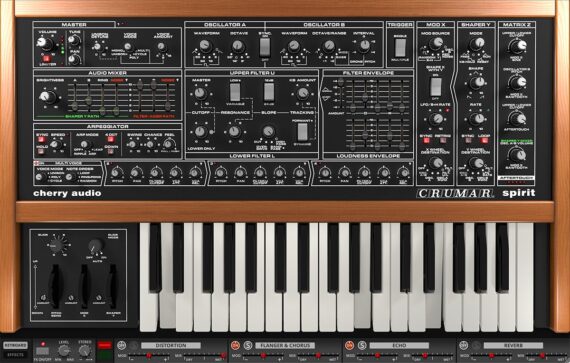Cherry Audio Crumar Spirit Virtual Instrument Now Available
Cherry Audio revives the cult classic Crumar Spirit in its latest plugin
Cherry Audio has introduced Crumar Spirit, a virtual instrument based on the classic hardware synth of the same name from 1983.
Cherry Audio is renowned for its software recreations of vintage synthesizers, having captured the spirit of legendary names such as the Roland Juno-106, ARP 2600 and Prophet-10 in plugin form, along with instrument like the Novachord.
Cherry Audio’s latest synth sights is the Crumar Spirit, an Italian analogue monosynth released in late 1983 that’s considered something of a cult classic. Designed by none other than Bob Moog (in collaboration with Tom Rhea, Jim Scott and Sante Crucianelli) the Spirit is known for its complexity and sonic versatility, along with its ultra-rare status: fewer than 100 units were manufactured before Crumar folded in 1986.
Fast forward to 2008, and the Italian company VMConnection acquired the Crumar brand before relaunching a modernized version of the Spirit in 2023. Cherry Audio’s software emulation has been developed in collaboration with Crumar, replicating the innovative design of the original instrument while bringing increased polyphony, enhanced modulation capabilities and a handful of useful new features.
“Spirit is a gateway to sonic experimentation, whether you are after wild, unpredictable timbres or warm, analogue tones” reads a statement from Cherry Audio. “It is not a polite instrument. Nor is it clean, safe, or obvious. However, twist a few knobs and it will reward you with some of the most colorful sounds you have ever heard from a virtual analogue software synthesizer.”
Like the original, Cherry Audio’s Crumar Spirit is a two-oscillator synth with saw, triangle and square waveforms (the latter with variable pulse width) and its oscillators are somewhat unusually routed through two distinct signal paths.
The first path runs through Spirit’s dual resonant filters – one low-pass filter and and a second state-variable filter with high-pass, band-pass and overdrive modes, switchable filter slopes of either 12dB or 24dB and a formant mode for adding vocal-like colour – and its VCA section. The other is routed through a second mixer for blending in ring modulation and a noise generator controlled by Spirit’s Shaper Y envelope.
Along with EGs for both filter and amp envelope, Spirit’s modulation comes courtesy of two LFOs found in the Mod X and Shaper Y sections, which have been joined in Cherry Audio’s software emulation by a new Matrix Z section, a four-slot modulation matrix with 25 sources and 45 destinations.
In addition, Cherry Audio have upgraded Spirit’s multi-mode arpeggiator with swing, humanization and probabilistic sequencing, and introduced a suite of effects that includes distortion, chorus, flanger, delay and reverb.
Voice modes now include monophonic, unison and a cyclic mode that adds per-note variation, along with a polyphonic mode with up to 16 voices, and the synth has been brought into the 21st century with velocity and polyphonic aftertouch.

Features:
- Based on the original synthesizer and circuit designs of Robert A. Moog, Tom Rhea, Jim Scott, and Crumar’s Sante Crucianelli
- Expanded functionality and modulation options
- Monophonic, unison, polyphonic (4, 8, or 16 voices), and cycle voice modes
- Multi voice modes for unison, poly, and cycle that add per-note variation by adding three additional “mini synth” panels, each with their own pitch, pan, filter frequency, VCA Envelope Attack, and VCA Envelope Release settings
- Quick-access Multi voice panel presets such as Hard Panned, Slightly Detuned, Well Worn, and more to simulate subtle or extreme variations between voices
- Over 430 presets in a dozen categories
- Two oscillators with master tune, octave, waveshape, and oscillator sync
- Oscillator B features modes to create a fixed frequency in two ranges – Bass and Wide – for drones, audio-rate modulation, or an additional LFO
- Dedicated Upper low pass filter and multimode Lower filter
- Flexible filter section with keyboard tracking, a fixed formant option for the Lower filter (to add vocal-like color), and low pass slope options
- Two ADSR envelopes with velocity for filter and amp
- Extensive modulation options in Mod X and Shaper Y sections, each routable to dedicated mod wheels
- Mod X modulation sources: Triangle, Square, Random (Sample & Hold), Shaper Y, Red Noise, Oscillator B. Sync or retrig
- Mod X destinations: Oscillator A + B, Oscillator A, Oscillator A rectangular width modulation (RWM), Filter Upper + Lower, Upper Filter
- Shaper Y modes: Free Run (extra LFO), KB Hold, Run, Reset (Envelope and Filter Effects). Sync or loop.
- Shaper Y destinations: Oscillator A + B, Oscillator B, Oscillator B RWM, LFO Rate, Lower Filter
- Cherry Audio’s “Matrix Z” four-slot mod matrix with four independent pathways to send modulation from one of 25 sources to any of 45 destinations, each with its own amount knob
- Multiple gate options for ADSRs allow for complex triggering
- Two independent mixers and signal paths for Shaper Y and Filter/ADSR with independent outputs
- Glide and pitch bend controls
- Dynamic arpeggiator with three modes – Ripple, Arp, and Leap – with Swing, Chance, and Feel to add degrees of randomness to arpeggiated patterns
- Two independent chains of studio-quality integrated effects with a global effect modulator:
- Filter/ADSR Effects: Distortion, Flanger & Chorus, Echo, and Reverb
- Shaper Y Effects: Envelope Filter, Dual Phaser, Flanger & Chorus, and Echo
- Standalone virtual instrument and plug-in versions included
- DAW sync
- User-adjustable oversampling control
- Complete MIDI control and DAW automation for all controls, with MIDI learn and mapping (Preset and Global)
- Cherry Audio’s Focus zoom-in feature, as well as standard UI zoom and resize via drag
- Complete documentation available directly online from the instrument or in downloadable PDF format
Cherry Audio’s Crumar Spirit is available now for macOS & Windows for $59.

























